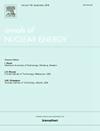不同类型裂变源发射中子的屏蔽和剂量学参数的研究
IF 1.9
3区 工程技术
Q1 NUCLEAR SCIENCE & TECHNOLOGY
引用次数: 0
摘要
本研究利用蒙特卡罗模拟,评估了各种裂变源发射的中子的屏蔽和剂量学特性。中子辐射对核应用和核安全至关重要,通过可裂变同位素的光谱进行分析。研究的重点是确定各种屏蔽材料的平均影响-剂量转换系数、平均总宏观截面以及通量和剂量等效累积系数。结果表明,中子通量和剂量当量累积因子随屏蔽层厚度的增加而增加,受屏蔽材料有效质量数的影响显著。值得注意的是,混凝土的堆积系数最高,而水的堆积系数最低。此外,由源和材料系数参数化的多项式方程有助于精确计算通量和剂量等效累积因子。这项研究增强了对中子屏蔽效能和剂量学的理解,这对于优化从反应堆操作到医疗应用等各种核环境中的辐射防护措施至关重要。本文章由计算机程序翻译,如有差异,请以英文原文为准。
Investigation of shielding and dosimetric parameters for neutrons emitted from various types of fission sources
This study evaluates the shielding and dosimetric characteristics of neutrons emitted from various fission sources, utilizing the Monte Carlo simulations. Neutron emissions, crucial in nuclear applications and safety, are analyzed across a spectrum of fissionable isotopes. The work focuses on determining the mean fluence-to-dose conversion coefficients, average total macroscopic cross sections, as well as the flux and dose-equivalent buildup factors for various shielding materials. Results highlight that neutron flux and dose-equivalent buildup factors increase with shield thickness, influenced significantly by the shielding material’s effective mass number. Notably, concrete exhibits the highest buildup factor, contrasting with water, which shows the lowest. Furthermore, polynomial equations parameterized by source and material coefficients facilitate accurate flux and dose-equivalent buildup factor calculations. This study enhances the understanding of neutron shielding effectiveness and dosimetry, which is crucial for optimizing radiation protection measures in various nuclear contexts, from reactor operations to medical applications.
求助全文
通过发布文献求助,成功后即可免费获取论文全文。
去求助
来源期刊

Annals of Nuclear Energy
工程技术-核科学技术
CiteScore
4.30
自引率
21.10%
发文量
632
审稿时长
7.3 months
期刊介绍:
Annals of Nuclear Energy provides an international medium for the communication of original research, ideas and developments in all areas of the field of nuclear energy science and technology. Its scope embraces nuclear fuel reserves, fuel cycles and cost, materials, processing, system and component technology (fission only), design and optimization, direct conversion of nuclear energy sources, environmental control, reactor physics, heat transfer and fluid dynamics, structural analysis, fuel management, future developments, nuclear fuel and safety, nuclear aerosol, neutron physics, computer technology (both software and hardware), risk assessment, radioactive waste disposal and reactor thermal hydraulics. Papers submitted to Annals need to demonstrate a clear link to nuclear power generation/nuclear engineering. Papers which deal with pure nuclear physics, pure health physics, imaging, or attenuation and shielding properties of concretes and various geological materials are not within the scope of the journal. Also, papers that deal with policy or economics are not within the scope of the journal.
 求助内容:
求助内容: 应助结果提醒方式:
应助结果提醒方式:


